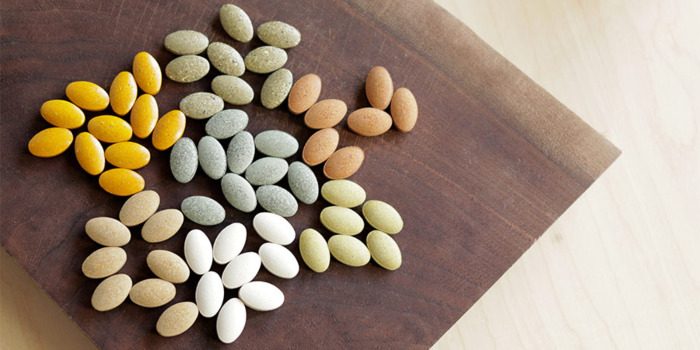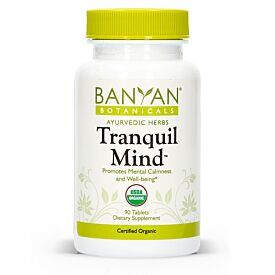How to Take Herbal Tablets

Herbal tablets can be an incredible boon to your health and well-being, but if you haven’t taken them before, getting started can evoke a lot of questions. In this guide, we hope to address the most common questions about taking herbal tablets. We also hope to make it abundantly clear that, at the end of the day, no matter what other considerations may be brewing in your mind, the most important thing is that you actually take your herbs! This is the only way that they can help you.
Courting a Relationship with Your Herbs
Taking herbs is a fundamentally different process than taking pharmaceuticals. When we take herbal tablets, our bodies are developing an intimate relationship with the plants that have been dried and prepared in each tablet. These plants have an intrinsic intelligence and life-force energy (prana) that they are lending to us—as we ingest them—in service of our optimal health and well-being. Ultimately, the tastes, qualities, and unique capacities of each herb serve to activate our own bodily intelligence, catalyzing a synergistic relationship that invariably deepens over time.
When taking herbs, the results can either be immediate and quite dramatic, or they can be far more subtle and cumulative. It all depends on the interplay between your body, the imbalances at play, and the herbs in question. Being conscious of the relationship you are entering into with your herbs can be quite beneficial, as can nurturing a certain respect and gratitude for the plants themselves, and for all of the energy that went into bringing their gifts to you.
Tablets vs. Capsules
One of the benefits of taking herbal tablets (over capsules) is that tablets allow you to taste your herbs. From an Ayurvedic perspective, digestion begins in the mouth with the sense of taste, and since the digestive fire (agni) is the cornerstone of health, the quality of our digestion has everything to do with our overall health. Being able to taste your herbs (even for a brief moment) expands the communication that’s possible between your herbs and your body, fostering a deepened relationship between the two.
The Bottom Line
All too often, herbal tablets end up sitting on a shelf, forgotten. So before we get any further into the art and science of taking herbal tablets, we want to emphasize one thing:
Everything in this resource is intended to support that process. So if you find yourself feeling overwhelmed in any way, at any time, it is important to come back to this one basic directive: JUST TAKE YOUR HERBS! The bottom line is that, if you embrace taking your herbs every day, you will be far better able to assess the benefits of doing so over time. On the other hand, if you fail to take your herbs consistently, it will be much harder to measure whether or not they are serving their intended purpose.
One of the beauties of herbs is that while they can be quite potent and powerful, they are also generally safe and benign. And even though there may be guidelines to help maximize the benefit you receive from various formulas, there is also really no way to get it wrong. Herbs are a lot like food; their potency is delivered through the digestive process, much like the nutrients you eat every day. So if you forget to take your herbal tablets at the intended time (whenever you decide that will be), rather than skipping them altogether, take them as soon as you remember—just as you would eat if you suddenly realized you hadn’t and that you were hungry.

Know Why You’re Taking Each Tablet
It’s also super-important that you’re clear on why you’re taking an herbal tablet. If you intend to take more than one formula, each of them should have a distinct purpose. This is the only realistic way to be able to evaluate whether a given herbal tablet is helping you or not. For this reason, we strongly recommend against taking two or more different herbal tablets for the same condition. That said, you are welcome to take several types of herbal tablets concurrently. Most of us here at Banyan certainly do! The trick is to know what each one is for, and to establish a way to track your progress with each condition independently.
For example, perhaps you recently created your Ayurvedic Profile™ (if you haven’t, we highly recommend doing so). Let’s imagine that your results recommended a focus on balancing vata, in part with the Vata Balancing Bundle, which you purchased. Here is how you might distinguish a clear purpose for each herbal tablet included in your bundle:
Healthy Vata.
Healthy Vata tablets are intended to balance vata systemically, so you will want to be paying attention to changes in your experience of things like anxiety, flightiness, forgetfulness, loneliness, your capacity to focus, or whatever signs of elevated vata are most common for you to experience.
Vata Digest.
Vata Digest tablets are specifically geared toward helping reduce vata in the digestive tract, so you’ll want to be tracking changes in your digestive capacity, and more specifically, the presence or absence of burping, gas, bloating, variable appetite, and any tendency toward dry, hard stools, or constipation.
Triphala.
Triphala tablets provide systemic nourishment and will also support healthy elimination so you will be paying attention to your stools and noticing their regularity, consistency, shape, stickiness, smell, and also whether or not they feel complete.
If at any time the distinctions between two herbal tablets do not feel clear to you, another workable approach is to introduce two or more tablets over a period of time, noting the effects of each one individually for one to three weeks before adding another.
Before You Begin
The best way to ensure that your herbal tablets are delivering maximum benefit is to begin the process purposefully and with awareness. Take the time to get clear about why you’re taking each herbal tablet, what changes you’re looking to create, and where you are beginning your journey. You’ll also want to decide how many tablets you will take and when, design a system for holding yourself accountable, and devise a plan to measure the efficacy of your herbal regimen. What follows is a series of five steps that we recommend you engage with for each herbal tablet you plan to introduce.
1. Set an Intention
The purpose of setting an intention is to clarify why exactly you are taking a given herbal tablet, as well as how, specifically, you hope it will help you. Here are a few examples. If you plan to take Triphala tablets, your intention might be to have a bowel movement every morning upon waking. If you’re taking Joint Support tablets, an appropriate intention might be to have more comfortable joint movement in your left knee, even with consistent activity. And if you’re taking I Sleep Soundly tablets, your intention might be to sleep soundly for seven hours each night. Of course, for each herbal tablet, there are many different possible intentions. For instance, here are a couple more that could apply to I Sleep Soundly tablets:
- Wake no more than once during the night.
- Awaken feeling rested and refreshed.
If all of this feels overly complex, let it go for now. Remember, the bottom line is: JUST TAKE YOUR HERBS!
2. Establish a Reference Point
A reference point gives you a firm understanding of your starting point. It is usually best to relate it to the intention in some way, and also to the experiences you will be tracking as you assess whether a given herbal tablet is serving its intended purpose or not. So for the above intentions, here are some possible reference points:
| Herbal Tablet | Intention | Reference Point |
| Triphala | Have a bowel movement every morning upon waking. | I currently eliminate upon waking about once per week and have a total of around five bowel movements per week. |
| Joint Support | Have more comfortable joint movement in my left knee, even with consistent activity. | My left knee currently feels sore after any significant activity. |
| I Sleep Soundly | Sleep soundly for seven hours each night. | I am currently getting about five hours of sound sleep per night. |
| I Sleep Soundly | Wake no more than once during the night. | I currently wake up 3–4 times per night. |
| I Sleep Soundly | Awaken feeling rested and refreshed. | I currently feel exhausted and depleted when I wake up. |
Feel free to customize both your intentions and your reference points to your situation. Keep in mind that the more specific and measureable they both are, the easier it will be for you to assess how well your herbs are supporting you.
If you have no idea how to establish a reference point for your particular condition, take the pressure off and move forward without it. JUST TAKE YOUR HERBS!
3. Make a Plan
Next, it’s time to decide how many tablets you’ll take, how many times per day, and when. If you have seen a practitioner who has recommended a particular herbal protocol, please follow their instructions. If not, begin by reviewing the herbal tablet’s suggested use for recommended quantities and frequencies.
In general, we advise that you start with a smaller serving, less frequently—at least until you know how your body will tolerate a new herbal tablet. If you feel like you need or want more, you can gradually increase the number of tablets per serving, the frequency you're taking them, or both over the course of one to three weeks. This will allow your body to develop a relationship with your herbs while inviting you to sharpen your self-awareness around how much is right for you. Being safe and benign, it would be difficult to overdo Banyan’s herbal tablets. That said, taking massive quantities could invoke a healing crisis, so we recommend a slow, purposeful introduction that gives your system time to adjust to the new input and to make graceful changes over time. It is also important to remember that herbal effects can be quite subtle, especially at first, so even if you don’t feel big shifts right away, the herbal tablets may very well be working for you. Give the process some time.
One of the primary principles of Ayurveda is that we are each different. Some of us have dense and hearty constitutions that require a large amount of input before we notice a change; others are exquisitely sensitive and can feel even the slightest internal shift instantaneously. The truth is that you know you (and your level of sensitivity) best, so trust your judgment and your sense of what feels right as you establish a routine with your herbs.
If you find yourself wanting further direction on when and how often to take different types of herbal tablets, here are some very general guidelines:
Rejuvenating Herbs.
These are formulas like Healthy Vata, Healthy Pitta, Healthy Kapha, Joint Support, and Ashwagandha tablets—herbs that are being taken with the primary intention of building, nourishing, and strengthening either the entire system, or a specific organ, tissue, system, or function in the body. We recommend taking these herbs up to three times per day, at any time that is convenient for you (and that will be easy to remember).
Digestive Herbs.
These are formulas like Vata Digest, Pitta Digest, and Kapha Digest tablets—herbs being taken with the primary intention of supporting the digestive process and kindling or balancing agni (the digestive fire). All things being equal, we recommend taking these herbs before, during, or after meals. Note: if you are specifically trying to improve your appetite, you may find that taking these herbs before a meal has a more potent effect.
Cleansing Herbs.
These are formulas like Blood Cleanse, Neem, and Triphala Guggulu tablets—herbs that are being taken with the primary intention of detoxifying and cleansing either your system or a specific organ or tissue. All things being equal, we recommend taking these types of herbal tablets on an empty stomach at least twenty minutes before meals, easing into taking them up to three times per day.
Elimination Support.
These are formulas like Triphala, Amalaki, and Haritaki tablets—herbs being taken with the primary intention of fostering healthy, balanced, and complete bowel movements. We recommend taking these herbs on an empty stomach either first thing in the morning, before bed, or both.
Sleep Support.
These are formulas like I Sleep Soundly, Tranquil Mind, and Ashwagandha tablets—herbs being taken with the primary intention of improving the quality of your sleep. We recommend taking these herbs immediately before bed.
As you can see, the same herbal tablets can be classified in more than one category. It depends entirely on your intention, which should guide your plan as much as anything else. The table below illustrates the above guidelines.
| Type of Herb | Intention | Examples | When? | How Often? |
| Rejuvenating | To build, nourish, or strengthen the system or a specific organ, tissue, system, or function | Healthy Vata Healthy Pitta Healthy Kapha Joint Support Ashwagandha Tranquil Mind |
Whenever convenient and easy to remember | Up to 3 times per day |
| Digestive | To kindle and balance the appetite or the digestive fire | Vata Digest Pitta Digest Kapha Digest |
Before, during, or after meals | Up to 3 times per day |
| Elimination Support | To support complete, regular, and balanced bowel movements | Triphala Amalaki Haritaki |
Upon waking, before bed, or both | Typically 1–2 times per day |
| Cleansing | To cleanse or detoxify the system, or a specific organ or tissue | Blood Cleanse Neem Triphala Guggulu Trim Support |
On an empty stomach at least 20 minutes before food | Up to 3 times per day |
| Sleep Support | To support improved quality of sleep | I Sleep Soundly Tranquil Mind Ashwagandha |
Before bed | Typically 1 time per day |
Once you have a plan, do your very best to stick with it for a designated period of time as you form a new habit. And if you feel like you're ready to go a little deeper, consider adding a carrier substance when you take your tablets.
Feel overwhelmed? Don’t stress. You can feel great about taking one or two tablets, one to three times per day, whenever it will reliably work for you. JUST TAKE YOUR HERBS!
4. Design an Accountability System
Precisely because consistency is the most important factor in supporting the efficacy of any herbal regimen, establishing a system to hold yourself accountable can help you get the best possible results from your herbal tablets. Think of this as a loving support system designed to help you stay on track. Accountability will be the most critical at the beginning of your journey as you introduce a new behavior, but you may find it helpful to continue as long as you are taking each herbal tablet.
There are countless possibilities; the most important thing is to pick a system that resonates with you and feels supportive. Feel free to dream up whatever solution will serve you best. Here are some suggestions to get your ideas flowing:
Find an Accountability Partner. Enlist the support of a friend or family member and decide how they will support you in sticking with your herbal regimen.
Set Reminders. Set reminders on your phone or calendar to help you stay on track.
Create Checklists. Create Daily Routine checklists that you will follow each day. To make this part easy, we have created a Daily Routine Check In that you can print and fill in each week.
And if you are nervous about holding yourself accountable or have no idea how to approach it in this moment, don’t fret. JUST TAKE YOUR HERBS!

5. Prepare to Track Your Progress
The mind is a tricky thing. When we don’t feel good, our ailments are often all that we can think about. But once we feel better, something strange happens, and it’s almost impossible to connect with how badly we felt before. This makes it extremely difficult to track positive change over time. Our minds are always adapting to the “new normal” and forgetting how things used to be. For this reason, it’s very important to find ways to track (and record) your progress. Otherwise, you will find it quite difficult to appreciate how far you’ve truly come. Tracking progress is also critical in being able to evaluate whether an herbal tablet is actually benefitting you. If you’re not paying attention, you may miss an opportunity to adapt your protocol for improved results, or overlook the evidence that’s telling you it’s time to consider switching to a more supportive formula.
The best solutions for tracking progress will help you quantify and document your qualitative experience, which can be challenging, but is generally well worth the effort. As we have said many times already, you are best equipped to decide what will work for you, so take the ball and run with it. Here are a few ideas to get you started:
Keep a journal. Write a daily log of what you’re noticing around your intentions. Periodically take time to look back over your journey and assess your progress.
Use an app. There are many apps out there to measure progress on goals and tasks. Find one that works for you and your intentions. Use it daily.
Create qualitative rating scales. Come up with a number system to rate your experience. Here’s one way to do this:
- Connect with the worst experience you can remember in the last year related to this condition. This will be a “1” on your scale. Write down a brief description of that experience.
- Now connect with your current average experience and write a brief description. This will be a “3” on your scale.
- The “2” on your scale will be an experience about half-way between the “1” and the “3.” Write a brief description of that.
- Now connect with where you want to be—the highest level experience you can imagine (this will be a “5” on your scale) and write a brief description.
- Connect with an experience about half-way between 3 and 5, which will be a “4” on your scale, and describe it briefly.
Now you have a rating scale that will help you easily identify and track a wide range of experiences. Keep the scale in a place where you can reference it daily. At the end of each day, write down the number that best represents your experience for that day. Track your weekly and monthly averages and watch them improve!
Get creative. There are many ways to track progress. If you are thinking of something that you imagine might work well for you, give it a go!
Haven’t a clue how to track your progress? Set it aside for now. JUST TAKE YOUR HERBS!
Claim Your Vision
When it comes to self-care, buy-in is important. In other words, our minds often need to understand why we’re doing something in order to be fully on board (and in order to avoid any tendencies towards self-sabotage). It is one thing to say to yourself, “I’m going to take these herbal tablets because I think they will help me feel better.” It is a different thing entirely to proclaim a vision for your future that’s both inspiring and specific. This is why we recommend this final (and completely optional) pursuit of engaging with your big-picture vision. The process involves just two simple steps:
- Write a “vision statement” in the present tense, as if all the desired changes in your life have already come to pass.
- Practice visualizing yourself in that new reality. Imagine what your life is like after you’ve embodied the level of health and wellness you most want, and picture yourself living that life.
A vision statement is quite different from an intention in that it expresses what your life looks and feels like on the other side of the changes you are calling in. It is far more comprehensive and can include the results you’ve received from several different herbs or formulas, dietary changes, or lifestyle improvements—whatever you’re working on, really. The purpose of the vision is twofold. First, it gives you a navigational tool for where you want to go. Secondly, it provides an ingredient essential to your success: motivation.
Once you have your vision, consider writing it down and displaying it in a prominent location where you can see it and connect with it daily. When you find your motivation waning (which is bound to happen from time to time), use your vision to reinvigorate your commitment to radiant health and well-being—whatever that looks like for you.
Here is an example of a vision statement for someone introducing Ashwagandha tablets for systemic rejuvenation and vata pacification:
“I am vibrantly healthy on a cellular level. My system is wholly rejuvenated. I sleep soundly at night and I have steady energy throughout each day. I feel strong, capable, engaged, and yet relaxed. My mind is calm and clear and I am able to meet the challenges that arise from one day to the next with grace and clarity.”
And if you’re not clear on your vision, or don’t have time to create one right now, it doesn’t matter. JUST TAKE YOUR HERBS!

Your Long-Term Success
So after you’ve got all of your intentions and plans worked out, and you’re taking your herbs daily, what then? Where are you supposed to focus when the weeks and months begin to pass? When will you see progress? And how will you know when to stop taking your herbal tablets?
When Can You Expect Results?
As with many things in Ayurveda, the answer to this question is: it depends. As we have already discussed, each of us is different. The depth and intensity of our imbalances is equally unique, as are our established diet and lifestyle habits. To further complicate matters, each of us has a different level of self-awareness and sensitivity. Those who are either highly self-aware or highly sensitive are likely to notice subtle changes faster than those who are less attuned with their bodies or who rely on more obvious shifts before they take note. We also have to consider whether the herbs are a stand-alone treatment, or are being introduced alongside other supportive practices.
For example, if you are taking Stress Ease tablets to navigate an especially stressful time, but doing little else to support your nervous system or change your exposure to daily stressors, your results will be slower than for someone who chooses to actively reduce stress while taking herbs. Similarly, if you are taking Triphala tablets to support proper elimination, and you are eating a diet primarily composed of whole, nutritious foods, then you will likely see benefits sooner than someone who lives on processed foods and stimulants, but has decided to start taking Triphala tablets every day.
All of that said, many people report subtle shifts within a few days of taking a new herbal tablet consistently. More obvious results can take four to six weeks to fully manifest. However, as your capacity for self-awareness improves, you will become more and more astute at noticing subtle shifts in your well-being.
Please keep in mind that the benefits of any herbal regimen are cumulative. They increase in depth and intensity as you deepen into a relationship with your herbs. Generally speaking, the more chronic and serious an imbalance, the longer you should allow before expecting to see noticeable improvements. We recommend giving each new herbal formula a minimum of four to six weeks before deciding whether it is the right one for you.
Fine Tuning
Along the way, we encourage you to fine-tune your routine to find what best serves you. Don’t be afraid to experiment with taking different amounts at different times, more or less frequently. This is especially true if you’re not seeing as much progress as you would like. If you’re not noticing any improvement, please don’t wait four to six weeks before tweaking your regimen. Try adding a tablet to each serving, or adding an additional serving each day. Banyan has a ninety-day guarantee intended to support you in determining whether any given product is a good fit for you. Remember, your body is developing a relationship with the plants in your herbal tablets. Sometimes, a certain formula just won’t have the desired synergy with your body, and that’s ok. If you’ve changed things up and still aren’t seeing results, it’s fine to try something else. Explore whether there’s something similar that might work better for you, or call our customer service team to see if they can help you find a better match for your system.
How Long Should You Take Your Herbs?
Once you’ve found your rhythm, self-awareness will be critical in guiding your ongoing relationship with your herbal tablets, as well as when you feel it’s time to stop taking them. Because each of us is unique, there is no universal long-term plan that will work for everyone. Some people fear developing a dependence on an herb that is supporting a particular function in the body. But Banyan’s herbal formulas are derived from whole plants, so you are no more likely to become dependent on them than you are to become dependent on a particular food. In general, we recommend that you take your herbs for as long as they are benefitting you.
For some formulas, like Triphala tablets, it is not uncommon for people to take them daily for years—even for life. On the other hand, many people experience that the herbs awaken a natural intelligence within their bodies that, at some point, can continue on its own without the herbal support. If you want to see if this is the case for any particular formula, gradually wean yourself off of it, see how your body fares, and adapt your routine accordingly. There are many possible scenarios for ending a relationship with herbal tablets. Some herbs serve their intended purpose and come to a clear sense of completion, such as might be the case when your intention has become your reality and your condition remains stable without the herbal tablets. Sometimes, a change in season can bring about a desire to shift, either because your current regimen no longer feels seasonally appropriate, or because you are now inspired to focus on something that very much does. In general, taking a specific herbal tablet for three to six months at a time is very typical. But if you have an especially chronic condition, consider that, for every year you’ve suffered from it, you may want to take your herbal tablets for one month or more. Some people also like to alternate between periods of cleansing and rejuvenation.
Anything is possible and ultimately, the choice about whether or not to continue a specific herbal tablet is entirely yours. The most important thing is that you learn to trust yourself.
Key Takeaways
At this point, we hope that you feel crystal clear about two things:
- When all else fails, just take your herbs—whenever and however you can (or as soon as you realize you forgot).
- You know you best, so above all else, follow your own inner guidance and listen to what your body is telling you. Give yourself permission to play and experiment, and enjoy your process.
If we were to offer one final invitation, it would be to cherish the ally you are befriending in each herbal tablet. Acknowledge the life-force energy of your herbs—their innate intelligence and their power to catalyze healing. Be willing to extend a little gratitude for what the herbs are offering you, and visualize the type of support that you want from them. You are building an alliance between intelligent beings; honor the relationship, and you are likely to receive even deeper benefits.
We truly hope that your experience with your herbal tablets is a beneficial one, and we are here to support you if further questions arise.












